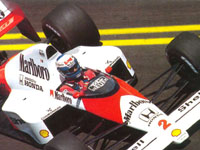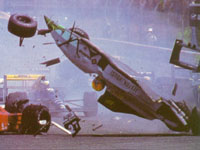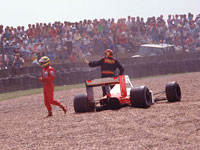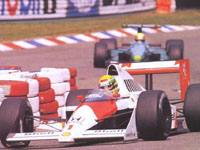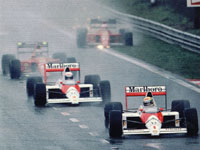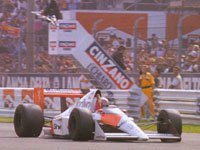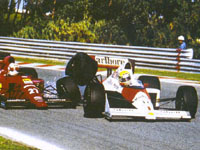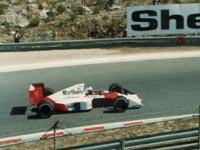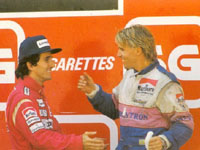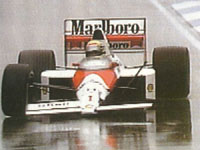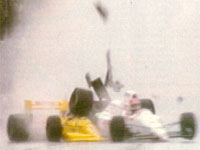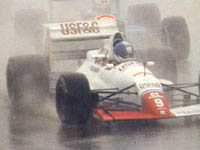The 1989 F1 season: so close to a different ending
Author
- Henri Greuter
Date
- February 3, 2010
Related articles
- 1989 French GP - Five debuts in one mid-season race, by Mattijs Diepraam
- Gerhard Berger - Racing with a smile on his face, by Leif Snellman/Greg England
- Honda - Honda: How it all started, by Thilo Figaj
- Nigel Mansell - Voted least likely Champion, by Mattijs Diepraam
- Alain Prost - Subtlety redefined, by Mattijs Diepraam/Rainer Nyberg
- Ayrton Senna - A carefully planned agenda to inspiration, by Mattijs Diepraam
Who?Ayrton Senna, Alain Prost What?McLaren-Honda MP4-5 Where?Suzuka When?1989 Japanese GP (October 22, 1989) |
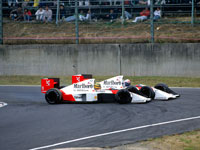 |
Why?
Several F1 titles have been decided in a cloud of controversy. Two of those deciders took place in 1989 and 1990. The 1990 outcome was to some extent the result of what had happened the year before, during the event that made 1989 so controversial in itself.
Alain Prost secured the title during the 15th race of the 1989 season, arguably the most controversial event that season. However, some things happened in the 13th and 14th race that in hindsight and with a more detailed look may be cause for quite a few thoughts. Most of those events are overlooked by many, primarily because of the dramatic impact and consequences of the events taking place in that 15th race of the season. Yet they could have decided the title battle before that controversial 15th race was run, even though the title would still have gone to Alain Prost.
Had this alternative scenario indeed unfolded, the outcry about how the season was decided would have remained tremendous, yet in a different manner and for different reasons. Nevertheless, the scenario isn't that unrealistic at all and could have happened so easily. Everything required to have taken place has indeed happened. There is nothing that needed to have gone differently.
It still primarily involves Ayrton Senna. Given the rather polarized opinions about the man, by both his fans and distractors, as well as the way in which Senna's 1989 season developed, it will be extremely difficult to unveil this scenario and convince the majority of Senna fans that this was a realistic and acceptable option. I'm still going to give it a try. Time to risk my neck, dive into the 1989 season and explain how and why the 1989 season could have ended in a very different way.
The F1 situation ahead of the 1989 season
The year before saw the creation of what appeared to be the most formidable team ever in F1: McLaren as one of the two best teams in F1 getting a new engine partner, Honda, builders of the best F1 engine, with the new cars driven by two of the four best drivers, if not the two best: Alain Prost and Ayrton Senna. They went unopposed in 1988 and decided the title between the two of them, Senna eventually taking the crown since his 11 best results out of 16 races were better than Prost's. Had every race counted, however, Prost would have overwhelmed Senna handsomely.
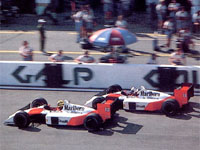 |
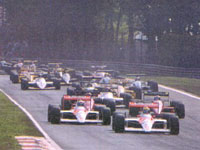 |
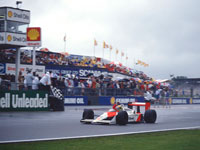 |
McLaren domination was almost surreal in 1988. Start of a new atmo era or not, things wouldn't be all that different in 1989. |
||
At the same time, the 1989 season was the start of a new era in F1. Turbocharged engines were banned, with only 3.5-litre atmo engines allowed now. When looking back on the season, its 16 races can be neatly divided into four quarters. Curiously enough, each of those quarters is notable for a different reason. So let's go through the 1989 Senna vs Prost duel step-by-step by dividing it into quarters as if it was an game of American football… We shall see that a comparison with that intense physical-contact sport isn't that strange at all.
Senna-Prost, First Quarter: 27-20
The season started with a major upset when Nigel Mansell won the first race of the season in a Ferrari that up until that moment had showed little reliability in testing. Senna collided with Gerhard Berger in the first corner - important contact no.1 - a collision that cost him the race although he was still classified 11th. Prost's race was compromised by a sick clutch, forcing him to nurse his tyres since he couldn't make a pit stop anymore. He salvaged second place.
Any hope that the 1989 season would turn into a fight among drivers outside of the two at McLaren evaporated in the second race of the season. the San Marino GP at Imola. The two fastest qualifiers, Senna and Prost, made a pre-race agreement that, for safety reasons, the man with the best start would remain unchallenged up to Tosa corner. Senna had the best start but the race was halted due to Gerhard Berger horrifyingly crashing his Ferrari.
At the restart after Berger’s accident, Prost assumed that the agreement was still valid but when he made the better start he was instantly passed by Senna, much to the Frenchman's dismay. Senna went on to win the event on aggregate of the two heats but Prost made it more than clear that in his view Senna had gone too far by not respecting their agreement at the restart. There had been some difficulties between the two men already but this time the damage was more severe, and the relationship between Prost and Senna went downhill from there on.
Ayrton apologized to Alain but later in the year he told Heinz Prüller, as can be read on page 51 of the Austrian's Grand Prix Story 89, he had done so on the request of Ron Dennis in order calm the tension in the team, not because he felt obliged to.
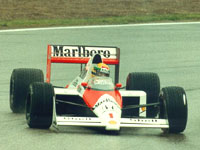 |
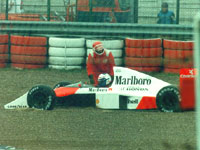 |
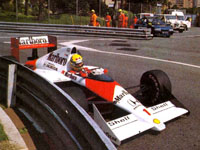 |
It was advantage-Senna during the first four races of the 1989 season but Prost controlled the damage by following in Ayrton's tracks. |
||
The Monaco Grand Prix was the third race of the season and also went to Senna. Prost's race was partly compromised by backmarkers not moving over but that didn't hide the fact that Senna had been the better driver again. Both now led the championship with 18 points each, Senna with two victories, Prost with three seconds.
The fourth GP of the season (Mexico) also went to Senna while Prost had an uncharacteristically weak race due to a bad tyre choice and ended up only 5th. Prost went public with his doubts about the equality of the Honda engines.
That was how the first quarter season ended. Prost appeared beaten with the weapons he used so effectively in the past, and little if anything stood between Senna and a successful defence of his world title. No-one expected this was to be the high point of Senna's entire season.
Senna-Prost, Second Quarter: 0-27 in the quarter, 27-47 for the title
The second quarter was notable for the fact that Senna failed to score a single point in any of its four races!
The fifth race of the season was at Phoenix, the kind of street race that Senna thrived at yet was disliked by Prost. Ayrton won pole but in the race he retired with electric maladies, handing victory to Alain, the first race of the season won by the Frenchman. Still, a single retirement for Senna was no problem and he still appeared to be in control of the season.
The sixth race of the season was a wet one and so advantage Senna to win that race since Prost was known to have become uncomfortable racing in the wet, unlike he had been before. Prost retired after two laps when his suspension collapsed. Senna ran away with the race but suffered a rare Honda engine failure with three laps to go. He was classified 7th and thus failed to profit from Prost’s retirement.
Alain still led the championship with 2 points over Ayrton but the odds were still favouring the Brazilian. In the two races from which he retired he had shown everyone the way home as long as he was in a healthy car.
The next race was in France and for a change it was Prost who took pole instead of Senna. The race had to be restarted after a massive first-corner accident. During the restart Senna’s gearbox broke, forcing him to retire. He then got into trouble with the officials for parking his car on the left side of the track instead of the right. They assumed he was closer to the right side and shouldn't have crossed the track as he had done. Eventually however, Senna was told that his explanation was accepted.
With Senna out of the race barely after the start, the race went to Prost. He extended the points lead to 11 but it wasn't an impossible job for Senna to catch up, with nine races yet to go.
Furthermore, the driver situation at McLaren showed its first signs of instability when Alain Prost announced that weekend that he wouldn't drive for McLaren in 1990. His motivation behind the decision was clear: he didn't want to be in the same team with Senna anymore.
The odds on a fourth mechanical retirement in succession looked slim, given the reliability record of both McLaren and Honda. Yet this was exactly what happened to Ayrton in the British Grand Prix when he spun off the track after a gearbox failure. Alain stayed out of trouble yet again and won his third race of the season. By doing so, he opened up a point lead of 20 points.
Halfway into the season the situation had changed dramatically. Senna now had a massive points deficit to make up instead of running away with the title as he appeared to be doing just four races ago.
Senna-Prost, Third Quarter: 24-24 in the quarter, 51-71 for the title
The second half and also the third quarter of the season started with a double for McLaren, their third of the season, all of them with Senna heading Prost. But this time the misfortune had gone to Prost. Leading the race and capable of defending his position against Senna, his 6th gear went away with little more than two laps to go. Even Senna admitted afterwards that had this not happened he might not have won the race. Despite his misfortune, Prost still finished second, his fourth of the season.
Ayrton took another three points away from Alain's points lead in the next race, the Hungarian GP. That race became noticeable for being the only event that year in which the pole didn't go to a McLaren driver, Patrese taking the honours for Williams-Renault. Both McLaren drivers had some difficulties to cope with during the race, Prost ending up fourth. Senna finished second. But during the race something happened that must have been a bitter humiliation for the Brazilian. Engaged in a duel for the lead, Senna and Nigel Mansell ran into backmarker Stefan Johansson. Ayrton uncharacteristically hesitated in making an overtaking attempt and before he knew what had happened he was passed by the Briton. This meant that Senna had to settle for second and lost out on an opportunity to eat a large chunk out of Prost's point lead, that was now at 14 points while it could have been 11.
Hungary '89 was a truly remarkable event for the McLaren-Honda combination that had existed since 1988, in that it was only the second time they failed to take pole position, Silverstone 1988 being the other. Furthermore, it was only the fourth time they lost the actual race, and it was also the first defeat they suffered because of another car-and-driver combination being better. The other races were lost because of a double retirement (Monza '88 and Montreal '89) and in Brazil '89 Alain Prost was forced to save his tyres, rendering him unable to challenge for the win. Was this a turning point in the season? Not that it could prevent a McLaren-Honda driver from becoming World Champion, but at least it could give us a few exciting races in which the other teams would take on the 'mighty Macs' for victory.
The points gap was down to 11 points after all after the 11th race of the season at Spa, a race that ended in the fourth McLaren double of the season, again with Senna beating his team mate.
The situation for Alain Prost, however, began to become worrying because of another reason. In 11 races he had scored 10 times so he was allowed just one more score before he had to drop his worst scores. Right now his three worst scores were a DNF, a fifth and a fourth. However, if Senna kept winning the remaining races with him finishing second, the worst scores Alain would have to drop were 2nd places…
Another worry for Prost was that ever since the British Grand Prix Ferrari had become more competitive and at long last, at least for Nigel Mansell, had become reliable enough to finish races. Berger’s car kept breaking down every race but by now there was the danger that Mansell would finish in between Senna and Prost on a regular basis, allowing the Brazilian to make up ground even faster. And if Berger would also find the kind of reliability Mansell had since summer… If Mansell (or Berger) defeated Senna as well it was less of a problem. In fact, Ferrari doubles ahead of Senna and Prost would be the most helpful way for Prost to win the title other than winning races himself.
Before the 12th GP, at Monza, the news came out that Prost was going to join Ferrari, thereby effectively swapping chairs with Ferrari driver Gerhard Berger who had signed for McLaren. It became one of the most unusual races for both McLaren and Ferrari. Again, Prost had to settle for second place behind his uncatchable team mate when, with 8 laps to go, Senna's engine blew! Prost inherited yet another victory, beating Gerhard Berger who scored his first points of the season. Both McLaren and Ferrari had the man leaving the team on the podium. Prost enraged team boss Ron Dennis even more when he threw his winner's trophy into the crowd. Trophies were so important for Dennis that McLaren driver contracts stated that any trophy won by the driver became the property of McLaren. It angered Dennis beyond belief to see Prost not honouring this paragraph of the contract.
And so ended the third quarter of the 1989 season. For the point situation it had little effect since the quarter had started with a 20-point advantage for Prost and ended with a similar margin. The big difference however was that Senna now had only four races left in which he had the chance to close the gap.
Still, the job wasn't impossible, All season long Senna had clearly been the better and faster driver. The deficit was the result of a driver error at Brazil and appalling reliability for McLaren-Honda standards. If Senna won the next four races he would still be home and dry since finishing second to Senna in each of those races wouldn't be of any help to Prost anymore. He had scored points on 11 occasions and had to drop his worst scores from now on, now being a fifth, a fourth and two of his second places. In fact, it was entirely plausible that Prost would again have to endure what happened to him the year before: scoring more points than the world champion over the entire season but losing out because of the eleven-best-scores rule.
And so we went into the fourth and final quarter of the season with Alain Prost apparently in command of the situation with a massive point lead. The reality however was that Prost was vulnerable against a utterly committed and driven team mate who was to stay with the team next year and was a favoured driver with the team's engine supplier. It was clear who, if they anything to say about it, the team wanted to be the 1989 champion. Alain had already expressed his fears about the team's driver preference with his statements about the Honda engines' inequality. Then again, if they had indeed been unequal in performance, it showed through their reliability rates. And in that aspect, Senna had come off much worse than Prost.
The third quarter of the season was over. Despite all the turmoil within McLaren, little could the team know that the real mess was yet to come.
The 13th GP: foundations for many ifs and buts
The next race took place at Estoril and for once McLaren had to battle for the front row positions. Ferrari was stronger than ever and managed to split the two McLaren drivers. Senna got his near customary pole but Prost was only fourth. Just about the worst scenario for Prost appeared to become possible, with Senna winning the race and himself finishing fourth behind the Ferraris. With such a scenario Senna would make up 8 points since Prost would only add one more point to his tally after, having to drop his earlier fifth place for a fourth.
Fortunately for Alain, things appeared not to go that bad initially. The Ferraris were extremely competitive on the day and both cars gunned into the lead, ahead of Prost and Senna. But then, on lap 40, it happened.
Mansell, leading the race, made his pit stop but the McLaren pit was still crowded and a mess. As a result Mansell overshot his pit. Instead of waiting for his mechanics to pull him back, Mansell selected reverse gear and drove back into his box. This is strictly forbidden. Mansell left the pits and rejoined the race in fourth which became third when Pierluigi Martini made his stop and went into a hot pursuit of Senna.
The officials, however, had decided to black-flag Mansell according to the rules. Indeed, a black flag was displayed at the start-finish line, along with a sign showing his start number, 27. The flag wasn't waived however and Mansell claimed later on that he had never seen the flag, being in a straight fight with Senna for second place. Another difficulty was that the drivers were heading into the direction of the sun, making things more difficult to see.
The race report as printed on page 214 of the famous Autocourse annual tells that Senna hadn't seen the black flag either, apparently confirmed by the fact that for three laps he refused to let Mansell pass.
Both Ferrari and McLaren teams failed to give their drivers the message that Mansell was disqualified.
By 1989, Ayrton Senna had already built a reputation for being impossible to overtake and going very far in preventing any such manoeuvre once he was challenged for position. As a result, he had already collided with Mansell twice, in the 1986 Brazilian GP and the 1987 Belgian GP. Mansell's successful move on Senna at the Hungaroring was almost the exception to the rule. And here, these two daring drivers were battling it out yet again. For Mansell had nothing to lose but the race, Senna on the other hand had just about everything to lose.
On lap 43, Senna was radioed by his team to let Mansell pass. Senna didn't understand and asked for a repeat. Seconds later, Nigel made a move on Ayrton's inside, who predictably shut the door and held his line into the corner. Unfortunately, Mansell was already alongside so the two men collided and spun off the track and out of the race.
The race was won by Berger, with Alain Prost promoted into second place. Since he lost two points by dropping a fifth as his worst score Alain extended his lead with four points instead of six. Then again, his championship lead had now increased to 24 points. This meant that Senna was forced to win each of the remaining races.
The championship was still open theoretically but at last the odds looked better for Prost than ever before during the season.
In the aftermath of the race, however, something happened that appeared to be logical at the time but became quite a bit less logical just one race later.
The Senna-Mansell collision was investigated by the stewards of the course. Mansell explained he hadn't seen the black flag but was still punished with $50,000 fine. The stewards also recommended that Mansell receive a one-race ban. The punishment was said to be only for ignoring the black flag.
The incident, however, had also almost settled the world championship in Prost's favour. So was the recommended ban some sort of punishment for influencing the world championship?
Shortly after, the recommendation by the stewards was taken over by none other than FISA president Jean-Marie Balestre. Mansell was notified of his ban for the Spanish GP the following weekend.
In the days following Mansell played his familiar dramatic games, even threatening to retire from racing because of his overly severe penalty. He claimed he wasn't aware even of committing his crime and given the manner Senna defended his position, neither was the Brazilian. And Senna had been in a better position to see the flag anyway, the Briton said.
According to Autocourse Senna hadn't seen the black flag. The only printed evidence I found suggesting that Senna had seen it after all was on page 209 of the German-language annual Grand Prix Story 89 by Heinz Prüller. The Austrian wrote that Senna acknowledged to his race engineer Steve Nichols later on that he “...feared Mansell would continue racing and classified at the end of the race. And he did not want to lose the title because of that.”
Eventually Mansell and Ferrari accepted the ban and so the Brit wouldn't be part of the Spanish GP. However, in this next race something took place that is almost entirely overlooked by many. Still, I am going to bring it up here in order to put Mansell's crime into perspective.
The 14th race: an equally sinful act deserving equal punishment?
During the first qualifying session on Friday morning Rial driver Gregor Foitek suffered a massive accident. Practice had to be red-flagged to allow an ambulance to come to Foitek's aid.
Everyone else but Senna failed to slow down and as was written on page 218 of the Autocourse annual's race report, the Brazilian was seen “running through eight black flags on the circuit, waved yellow flags at the scene of an accident and – most crucially – a red flag at the start-finish line”. On page 218 of his annual Grand Prix Story, Austrian writer Heinz Prüller wrote that Senna was penalized for crossing the finish line at full speed despite a red flag.
According to Autocourse “Senna could count himself exceedingly fortunate to get away with a $20,000 fine and having his times disallowed only up to the point of his transgression, The Brazilian rightfully accepted responsibility for the breach of the rules, but offered no justification…”
There is a question hiding in this Autocourse sentence.
Here was a driver who failed to respond to waved yellow flags at the scene of the accident and also ran through eight black flags shown in a single lap. Of course we don't know where, within the sequence of the black flags, he passed the yellow flags. Were all eight black flags visible after passing the yellows or was the scene of the accident somewhere in the middle of this sequence of black flags? On top of that, Senna ran through a red flag at the finish line.
Now, Senna wasn't in hot pursuit or trying to defend his position. There is every reason to believe that it must have been far easier for him to notice at least one if not more of the waved flags compared to seeing the lone black flag held stationary at the finish line the week before while looking into the sun and defending his position. It can be argued that Mansell committed his offense during the race while Senna made his in a practice session. Does that make a difference? It of any importance when it happens?
Nigel Mansell was fined $50,000 and banned for a race. Senna got away with his times up to that point being erased and a fine of $20,000. This seems to bear out that Mansell's ignoring a black flag during a race was seen as much more offensive. If anything, failing to notice so many flags in the space of a single lap wasn't regarded more offensive as failing to notice the same, single flag on three successive laps. So it seems that the two incidents, despite having similarities, weren't seen similar enough to be punished identically.
Then again, if they are indeed similar enough to warrant identical punishment, why didn't this happen?
Mansell's ban was advised by the stewards at the track before being enforced by Balestre. One big difference may be that the Portuguese stewards for whatever reason didn't advice such a ban for Senna. Balestre didn't have the instrument he used in Mansell's case.
A Senna ban, no matter if it was for the rest of the Spanish weekend or for the next race, would have had a direct effect on the outcome of the world championship. Senna could gain a maximum of 27 points in the three remaining races to overcome his 24-point deficit. Being banned for one event would have meant he could only score points in two more events, thus a maximum of 18, in which case the title had been Prost's. No doubt that banning Senna would have caused an outrage at McLaren and the Senna camp in particular, and among his fans worldwide. His title chances had been hurt enough already by his elimination in Portugal, by a driver who shouldn't have been in the race at that time.
There is much more to say and add to all of this, but let's wait a little and move further ahead in time. Not before making a final observation for the moment, however. Had Senna indeed been banned from the event it would have had another winner, since Ayrton kept his title hopes alive by winning the race. Even more interestingly, had a ban been enforced at the next race, Senna would not have been competing at Suzuka…
This means that the 1989 season could have been decided in Prost's favour right after the 14th race, without any of these 14 races needing to have run a different course than they in fact had. All that was needed was Senna's flag-ignoring offense being rated as equally serious to Mansell's the weekend before and punished accordingly. Instead, the title battle raged on and would create yet another outlook on Mansell's ban, this time because of the man behind it.
The 15th GP: The vulcanos erupt
The events of race day at Suzuka in 1989 and what followed right after and on the following days are enough to fill a booklet. So let's not go into analysing the Senna-Prost clash in that race but instead focus on the aftermath.
Senna was disqualified after crossing the line first. The reason for his DQ was given as failing to rejoin the race in the appropriate manner, having cut off the chicane. Senna's disqualification meant that Prost was the world champion. McLaren protested the disqualification.
One accusation made about Senna's DQ is that it was influenced by Jean-Marie Balestre in an attempt to help his fellow Frenchman secure the title. In the past Balestre had shown some signs of patriotism so the accusation didn't come entirely out of the blue. According to Heinz Prüller on page 240 of Grand Prix Story 89, Senna himself accused Balestre of manipulating against him.
In Terry Lovell's Bernie's game, published in 2003 by Metro Publishing, Balestre's suggested influence was downplayed. Chapter 12 is about how Max Mosley beat Balestre to the FIA presidency. Mosley had won support from the Japanese, including Toyota and the Japanese Automobile Federation (JAF). But then, Lovell adds, even without the support from Toyota, Mosley was in a more favourable position, due to Balestre's behaviour two years earlier during the Japanese Grand Prix of 1989 at Suzuka. According to Lovell, Balestre played a controversial part in the argument that followed after Ayrton Senna collided with Alain Prost on the 46th lap, in which the Frenchman tried to eliminate his arch rival in a race that was crucial for his title chances. In several descriptions of the events it is told that Balestre pursued Senna's disqualification. Senna accused Balestre of manipulating the race to the advantage of his fellow countryman, something that was widely mentioned in the media. However, in this case, Lovell claims, Balestre, who was known for using his authority within FIA investigations, was innocent. He made the error to enter the office where the stewards were going through the reports and studying the videos but didn't actively participate with the stewards in order to persuade them to take Prost's side. “That wasn’t the case,” said one of the stewards at the meeting. “The only thing he said was 'I am glad that I don't have to make this decision'.”
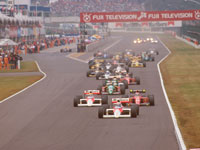 |
 |
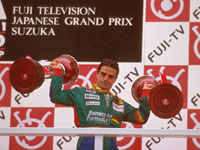 |
Alessandro Nannini took his only Grand Prix win in controversial circumstances. |
||
The decision to disqualify Senna was based on the fact that the Brazilian had restarted his car and rejoined the track, but not at the point where he left it but cutting off the chicane ahead of the start/finish line.
On page 240, Heinz Prüller wrote in his book that Senna told him it wasn't time yet to talk about what happened at Suzuka but Prüller also stated that the FISA officials swore there were “50 witnesses that Balestre wasn't with them”.
Did Balestre realize or feel secure that the stewards would disqualify Senna? In recent weeks the FISA had been punishing drivers heavily. An overview of how the FISA's incoming cash flow of the recent weeks looked like:
- Mansell: $50,000 for the Estoril black flag affair
- Prost: $10,000 for not attending the press conference at Estoril
- Brundle: $10,000 for speeding in the pit lane during practice
- Grouillard: $10,000 for neglecting a red light at the end of the pit lane
- Nakajima: $5,000 for an illegal rear wing
- Senna: $20,000 for ignoring waved yellow flags at the scene of an accident, ignoring black flags and a red flag at the start/finish line
The stewards themselves disqualified Senna, so Balestre had no reason to act in order to help Prost. It was done for him already. Still, maybe his sheer presence at the meeting (as suggested by Terry Lovell as having been the case) had motivated the stewards to disqualify Senna?
Why didn't Balestre help Prost when he had a golden opportunity?
Balestre was accused of playing a part in Senna's disqualification in Japan but based on the evidence I gave above there is reason to believe that despite of Balestre has done over the years to help Prost he wasn't directly responsible for the Japanese DQ.
As for the relationship between Prost and Balestre, according to Prost the two were no friends. The best statement by Prost about his personal feelings regarding Balestre is found on page 244 of Heinz Prüller's Grand Prix Story 89. The statement contains a lot that is of little relevance here, but for the sake of accuracy I translate the full remark in order to give an insight into the context in which Prost gave his comment. It was made in Adelaide, in the aftermath of Senna's final punishments and can be translated as follows: “Balestre certainly didn't punish Senna because he is French and wants to help me because I am French as well. We really don't have such a good relationship. We work very hard because of safety reasons, that's all.”
However, if Balestre had really wanted to help Prost the following question arises: after the way he disqualified Mansell for ignoring a flag why didn't he jump on Senna's back and had him disqualified because of the flags Ayrton ignored during practice at Jerez? If Balestre was so eager to help out his fellow countryman, this was the golden opportunity to do so. Would it have been seen as over the top and an abuse of his power?
Or did he fail to act because he needed a recommendation for punishment by the stewards like Mansell got? Or didn't he want to interfere with the title battle?
One way or another, the chance to assist his fellow Frenchman Prost presented itself to Balestre quite clearly but for whatever reason he didn't or couldn't use it. This becomes much more curious since McLaren's appeal against Senna's disqualification led to the FISA coming down even harder on the Brazilian. Apart from the entire Suzuka affair, on which FISA stated he had broken the rules no less than eight times, FISA also mentioned a serious number of recent driver errors by Senna, starting with the collision with Schlesser at Monza in 1988 and also mentioning his failing to obey the warning flags at Jerez.
For little over a year the FISA had allowed Senna to act the way he wanted. Only once did he get into problems with officialdom, which was the manner in which he retired from the French Grand Prix, but he was eventually cleared from that mishap. But now, all of a sudden, FISA came on Ayrton like a ton of bricks. In light of the things to come it was too much at the wrong time. FISA had lost a lot of credibility by letting other Senna incidents go unpunished but now they were brought up after all in order to disapprove of his behaviour. If these other incidents had really been a problem FISA should have acted earlier instead of dragging them out of a cup overflowing with yet another incident.
It does appear as if FISA acknowledged that in hindsight Senna wasn't punished for violations that should have earned him an earlier punishment. In which case the Mansell disqualification over a comparable violation can be seen in a different light. A neutral and objective verdict about the way FISA dealt with Senna in 1989 would be that he was treated wrongly all of the time: too mellow when a punishment would have been had been appropriate and, in reaction to that, too hard when it was too late for the punishment to have any effect.
And what if Senna's punishment had been identical to Mansell's?
The main issue regarding the difference in punishment between Senna and Mansell remaining the question whether the violations are indeed equally serious, and deserved to be punished accordingly. If so, was Mansell punished too severely? Or did Senna get off lightly? And whatever the case: why was this?
In case the incidents were seen as similar offenses Ayrton Senna had had to be excluded from a GP, first by the stewards at Jerez, and if Balestre had had enough power to enforce decisions, he would had been the second in line to have Senna banned.
Any form of race ban would have made Alain Prost the new World Champion instantly, but there are some thoughts about the ways in which the ban could have been applied. If Senna had been banned instantly from the Jerez race it would have created a lot of uproar and legal troubles. Because of that, the most severe punishment would have been to allow Senna to compete under probation and disqualify him retrospectively should elimination from the event be deemed the proper punishment. Something like this happened to Jacques Villeneuve in 1997 in the Japanese GP at, yup, Suzuka.
It's much more interesting, however, to see what would have happened if Senna had been treated the same way as Mansell, and had been excluded from the next race. It means that Senna would have missed Suzuka. It also means that the misery on the track and after the race wouldn't have happened.
One year later it was mayhem at Suzuka yet again: off-track between Senna and Balestre, on-track between Senna and Prost. I don't want to go into that incident here since it is an entirely different subject. However, I need to mention it briefly because having clinched the 1991 title at Suzuka Senna told in the press conference after that race that his actions in 1990 were influenced and caused by, among other things, the events of Suzuka in 1989 for which he wanted to take revenge.
That begs the question what Senna had done in 1990 had he indeed been banned from the Suzuka race the year before? He wouldn't have had Suzuka 1989 as an excuse for revenge in 1990. Since those actions ultimately went unpunished they also set new standards for acceptable on-track behaviour. Maybe Balestre (and/or the FISA in its entirety) had not only missed a golden opportunity to help out Prost by punishing Senna's flag-ignoring at Jerez with a fine and erasing his lap times up to that moment. They also missed the opportunity to retain the standards of acceptable driver behaviour for years to come.

